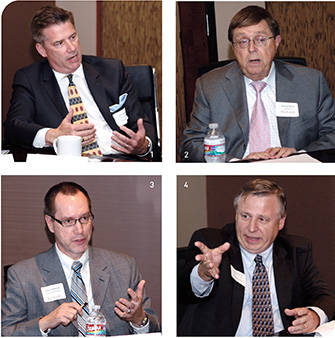
1. Many investors are more concerned about the security of their portfolios than about the rate of return, said John Woolway, | 2. Tommy Taylor believes that any changes in the estate-tax exemption level will follow historical trends, and benefit the taxpayer. | 3. A 4 percent withdrawal rate, said John Jespersen, is his firm’s target for ensuring capital preservation. | 4. David Neihart cited an oft-overlooked wealth-management tactic: Reining in the debt side.
Steve Soden, president and CEO of Great Plains Trust, is worried about
“the craziness for yield.” He believes that there will come a moment in the not-
too-distant future when “people are going to realize that they have stepped too far over the line as far as the balance of risk/reward.” That moment, he fears, will come too quickly for these individuals to rebalance their portfolios.
Tommy Taylor, an attorney with the Polsinelli, PC law firm, asked his colleagues what they were telling their clients to expect as a reasonable rate of return over the next 20 years.
“We tell clients you can safely withdraw 3 percent out of your portfolio, your spending rate, forever, because we feel that’s something under any scenario that we can cover,” said Steve Soden.KC Mathews said that for a balanced investor, 5–7 percent over the next 20 years is a realistic number. “I think there are many places to find yield,” said Mathews, but finding them takes a certain sophistication on the adviser’s part, as does the ability to communicate risk.
John Woolway, chief investment of-ficer with Vantage Investment Partners, contended that his high-net-worth clients were less interested in yield than they were in security.
“But it makes our job so much harder,” said Woolway, “when the Fed’s foot is just on the yield curve.”
David Neihart, a financial adviser for Wells Fargo Advisors, observed that low rates in terms of investing also mean historically low interest rates for borrowing. A useful strategy, he suggested, is to take advantage of both sides of the balance sheet. “What debt do you have?” he asks his clients. “What are you paying on that?”
“It really does boil down to strategy,” said John Jespersen, adviser at Buttonwood Financial Group. He spoke to the value of a newish concept known as a “withdrawal policy statement.” He believes that clients should be able to withdraw at a 4 percent rate, as opposed to 3, “but what we will do in that process of planning is make sure they’ve got the investments lined up appropriately.”
International Investing
“When it comes to international investing,” said Matt Melton, wealth management adviser at Northwestern Mutual, “it’s always a question of a well-thought-out, diversified portfolio.” As Melton noted, there are many great companies domiciled outside the United States. At the same time, there are emerging markets and frontier markets that have great potential but that are less stable. “Looking at the companies first and countries after that would be the important part of investing overseas.”
“There’s always opportunity,” said Bob Rippy. He observed that over the past 20 years, international returns had bested domestic ones a little more than 50 percent of the time. Emerging markets are more volatile, but have also performed relatively well over time. “The volatility can work in your favor if you’re taking the right strategy,” said Rippy.
“Emerging markets, you have to be very careful with them,” agreed KC Mathews. “To truly make money, [a market] needs to go from a truly awful situation to merely bad, and you’ll make more money than if you go from good to great.”
“Short term, we all know anything can happen,” affirmed Brett Broyles, “but I think when you look at international as a whole, there’s definitely some opportunity for the long-term investor.”
Lynn Mayabb noted the different tax rules and currency exchange issues that can be beneficial as well, and need to be assessed. As Rippy added, the corporate tax rate in the United States is among the highest in the developed world. “That in and of itself,” he said, “is an advantage in some of the foreign companies.”